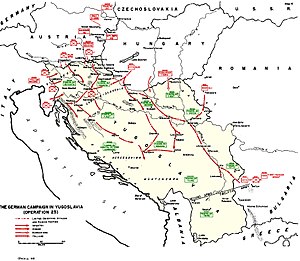Adriatic Campaign of World War II
| Adriatic Campaign | |||||||
|---|---|---|---|---|---|---|---|
| Part of Mediterranean and Middle East Theatre of the Second World War | |||||||
 Adriatic Sea in 1941, during the Nazi invasion of Yugoslavia |
|||||||
|
|||||||
| Belligerents | |||||||
|
Allies: (from 8 September 1943) |
Axis: (until 1944) (until 1944) (until 1944) |
||||||
| Commanders and leaders | |||||||
The Adriatic Campaign of World War II was a minor naval campaign fought during World War II between the Greek, Yugoslavian and Italian navies, the Kriegsmarine, and the Mediterranean squadrons of the United Kingdom, France, and the Yugoslav Partisan naval forces. Considered a somewhat insignificant part of the naval warfare in World War II, it nonetheless saw interesting developments, given the specificity of the Dalmatian coastline.
On 7 April 1939, Mussolini's troops occupied Albania, overthrew Zog, and annexed the country to the Italian Empire. Naval operations in the Adriatic consisted mostly of transport organisation through the ports of Taranto.
The Greco-Italian War lasted from 28 October 1940 to 30 April 1941 and was part of World War II. Italian forces invaded Greece and made limited gains. At the outbreak of hostilities, the Royal Hellenic Navy was composed of the old cruiser Georgios Averof, 10 destroyers (four old Theria class, four relatively modern Dardo class and two new Greyhound class), several torpedo boats and six old submarines. Faced with the formidable Regia Marina, its role was primarily limited to patrol and convoy escort duties in the Aegean Sea. This was essential both for the completion of the Army's mobilization, but also for the overall resupply of the country, the convoy routes being threatened by Italian aircraft and submarines operating from the Dodecanese Islands.
Nevertheless, the Greek ships also carried out limited offensive operations against Italian shipping in the Strait of Otranto. The destroyers carried out three bold but fruitless night-time raids (14–15 November 1940, 15–16 December 1940 and 4–5 January 1941). The main successes came from the submarines, which managed to sink some Italian transports and a submarine (Greeks also lost a vessel in the process). On the Italian side, although the Regia Marina suffered severe losses in capital ships from the British Royal Navy during the Taranto raid, Italian cruisers and destroyers continued to operate covering the convoys between Italy and Albania. Also, on 28 November, an Italian squadron bombarded Corfu, while on 18 December and 4 March, Italian naval units shelled Greek coastal positions in Albania.
...
Wikipedia
